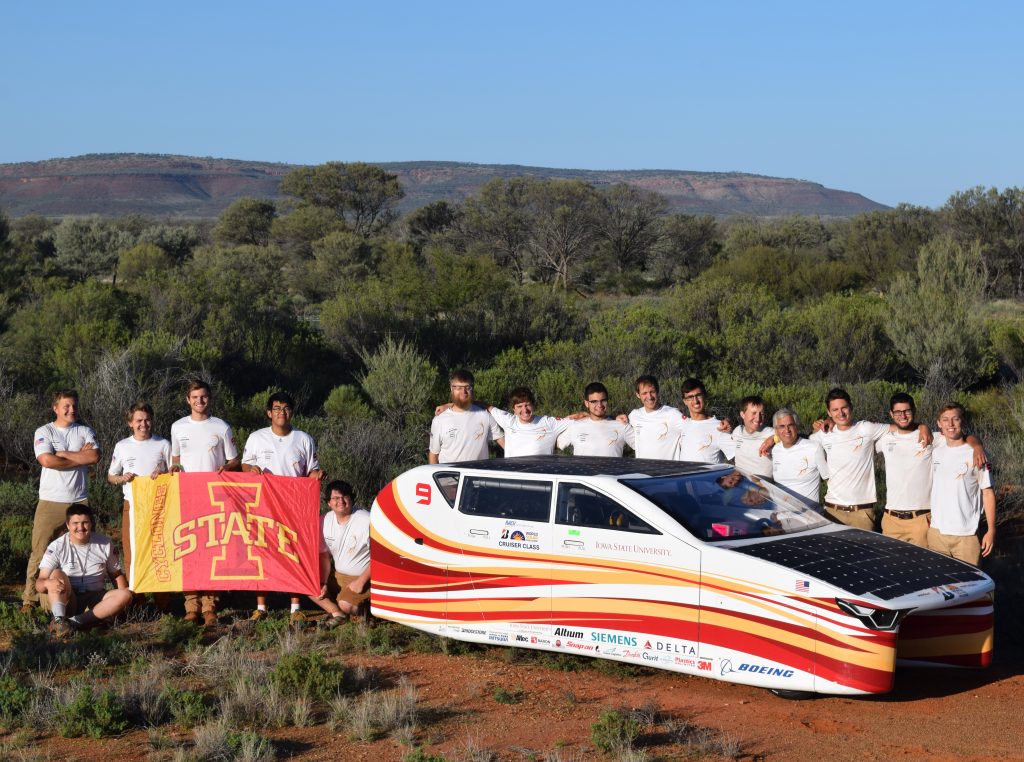Photos and field reporting by Nick Fetty, Mechanical Engineering Communications Specialist.
Four students with the of the Department of Electrical and Computer Engineering (ECpE) traveled across the Australian Outback with Team PrISUm in the Bridgestone World Solar Challenge.
The Bridgestone World Solar Challenge was a 3021-kilometer biennial race that began in Darwin in Australia’s Northern Territory on Oct. 8 and ended in Adelaide in Southern Australia on Oct. 15. In the race’s 30th year, 42 teams from over a dozen countries headed to the Outback.
Nathan Coonrod is a senior studying electrical engineering (EE) and specializes in batteries. He was the Assistant Electrical Director during the race.
Computer engineering senior, Lucas Ince, was the strategy manager for Team PrISUm.
Jason Cheng, EE sophomore, served as the electrical project director. He ensured projects got all the support they needed, as well as managed, designed and tested all the custom electronic boards that went on the car.
EE sophomore, Jason Baldus, acted as an electrical team member and was responsible for maintaining and repairing the electrical systems on the car. “My main role was to make notes of anything we did on the car, as well as any problems that could have arisen so we could have those solutions ready for the next time,” Baldus said.
Team PrISUm began the 3021-kilometer journey by driving 380 kilometers from Darwin to south of Ka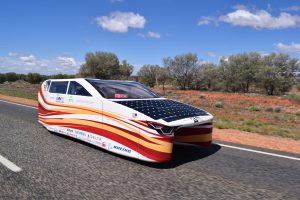 therine.
therine.
The team experienced their first round of battery issues shortly after their first controlled stop in Katherine, roughly 217 miles south of Darwin. After a brief charge, they were able to get back on the road and drive to their first rest stop of the race, where the team camped out beneath a clear, starry sky.
With temperatures hovering in the 90s and mostly clear skies, the team and the car – Penumbra – encountered what it suspects were issues with the battery overheating, similar to the first day of the race.
“We are stretching the limits of the batteries,” Coonrod said. “Battery temperatures are on the edge of what is tolerable, despite a comprehensive thermal system, and we have not received as much array power as expected. These issues have compounded to severely reduce our strategy options near the end of the day when road surface temperatures are over 125 degrees fahrenheit in the Outback.”
To prepare for the hot Australian climate, the team drove the car across Iowa’s 99 counties in an event dubbed SunRun. In addition to serving as an outreach opportunity, SunRun also aimed to provide the team a test run for the Bridgestone World Solar Challenge by driving the car across Iowa’s varying terrains during the hot midwestern summer.
In an effort to keep the battery cool while driving, Penumbra was designed with nacaducts, a set of intake slots at the front of the car which bring air from the road into the battery box.
“The nacaducts are working as expected, but ambient temperature is so close to the limit of our cells that the air we’re cooling with is too hot to operate. Many commercial vehicles utilize liquid cooling at the expense of weight to solve this problem,” Coonrod said.
The day, beginning south of Elliott in Northern Territory Australia and ending just north of Barrow Creek, started with 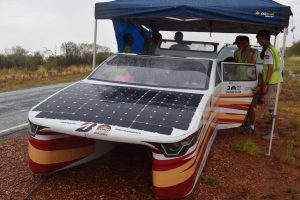 plenty of sun but ended with heavy rain.
plenty of sun but ended with heavy rain.
“The car performed as expected during this part of the day. We reached the stop with exactly what we expected to have,” Ince said. “The team worked quickly, efficiently and safely the whole day. I could not be more proud of this team and how they worked together today. We have a great group here.”
Around 2:30 p.m. local time, the team encountered heavy rain, which quickly turned the red dirt into muddy pools of water along the side of the road. This marked the first time during the race that the car experienced significant rain. The rain inhibited the Penumbra’s ability to absorb solar energy at a point in the race when the battery was already stressed, forcing them to pull over to evaluate the problem.
“The rain, specifically the cloud cover, was hard on the car. It’s hard to run a solar race without the sun,” said Ince. “The team reacted well to the rain, and we protected the car from damage while also keeping us all safe.”
Despite morning rainstorms, as the team departed from Alice Springs, the skies were mostly sunny as the team progressed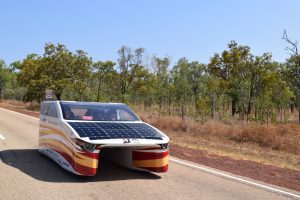 southward, allowing the car’s solar array to capture its needed energy.
southward, allowing the car’s solar array to capture its needed energy.
“The array performed admirably, especially with the cloud chasing strategy we adopted, going fast in shade and slowing to charge when necessary,” Cheng said . “We were reaching almost peak efficiency, exceeding our expectation at 600 to 700 watts.”
“We are going to do everything we can to make our team, our university and partners proud by getting Penumbra to the finish line,” said Cheng. “We have a unique opportunity to gather data with the time we have left. We’ll collect data when we can and will push our team to finish in Adelaide on Friday in time for practicality judging with all of the other cruisers.”
With one day to go, PrISUm Solar Car was less than 400 kilometers from the finish line in Adelaide.
The morning started about 20 miles north of Marla with temperatures in the low 60s, considerably cooler than the previous days, but no shortage of sunlight. The solar car, logged 230 kilometers on the day, driving through the country’s flatlands before hitting the controlled stop in the opal mining town of Coober Pedy, where temps had risen to the high 80s. From there, the team trailered Penumbra to the night’s camping spot about 60 kilometers north of Port Augusta.
Final Day
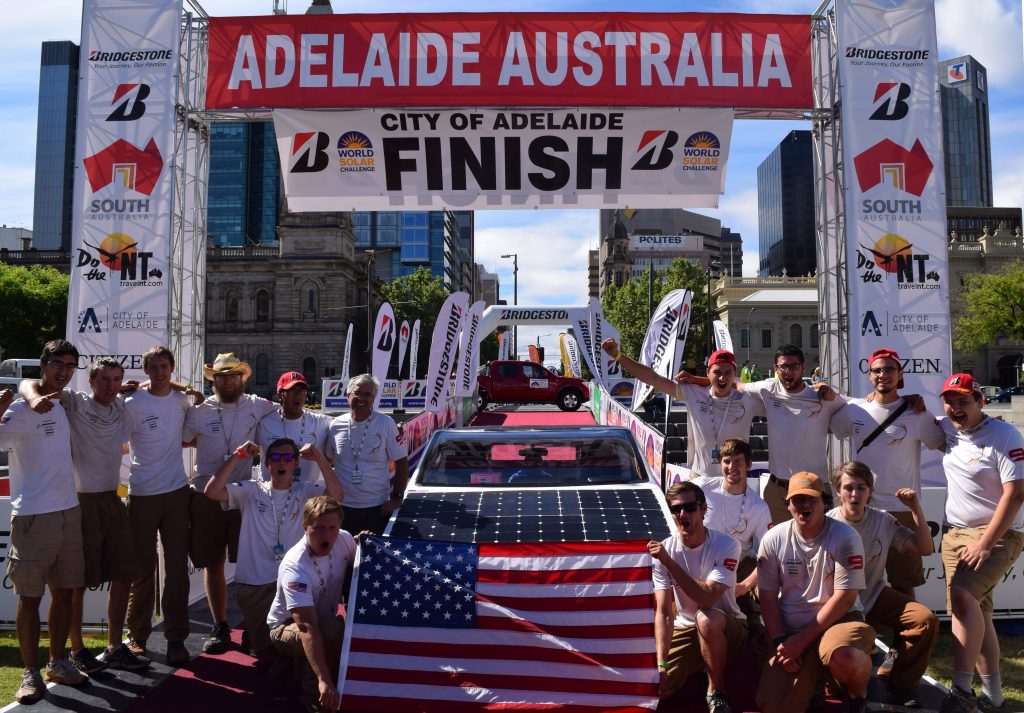 PrISUm Solar Car finished the 2017 Bridgestone World Solar Challenge in classic Iowa State style: Blasting Neil Diamond’s “Sweet Caroline,” ISU’s unofficial theme song, as they crossed the finish line in South Australia’s capital city.
PrISUm Solar Car finished the 2017 Bridgestone World Solar Challenge in classic Iowa State style: Blasting Neil Diamond’s “Sweet Caroline,” ISU’s unofficial theme song, as they crossed the finish line in South Australia’s capital city.
Temperatures were in the 70s, and skies were cloudy for much of the day. Despite the inconsistency of the sun, the solar car, had enough power stored in its battery to complete the race. “The advantage of having a battery in addition to the solar panels is that you can charge when it’s sunny, so you can still go when it’s not,” Ince said .
“The race was a challenge and at times very stressful, but being here in Adelaide and looking back on everything I did to make this car a possibility, it has been my greatest college experience,” Ince said.
